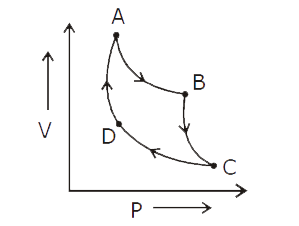For a gas CP−CV=R in a state P and CP−CV=1.10R in a state Q, TP and TQ are the temperatures in two different states P and Q respectively. Then
TP=TQ
TP<TQ
TP=0.9TQ
TP>TQ
To solve the problem, we need to analyze the given information about the gas in two different states, P and Q.
1. Understanding the Given Information:
- In state P: CP−CV=R
- In state Q: CP−CV=1.10R
Here, CP is the specific heat at constant pressure, CV is the specific heat at constant volume, and R is the universal gas constant.
2. Using the Relation:
- For an ideal gas, the relation CP−CV=R holds true. This means that in state P, the gas behaves like an ideal gas.
- In state Q, since CP−CV=1.10R, the gas behaves differently than an ideal gas. This indicates that the gas may be experiencing higher interactions or is at a lower temperature.
3. Analyzing the Temperatures:
- The problem states that TP and TQ are the temperatures in states P and Q, respectively.
- Since state P behaves like an ideal gas, we can infer that it is at a higher temperature compared to state Q, where the gas does not behave ideally.
4. Conclusion:
- Based on the analysis, we can conclude that TP>TQ. This means that the temperature in state P is greater than the temperature in state Q.
Thus, the final answer is:
TP>TQ
- In state P: CP−CV=R
- In state Q: CP−CV=1.10R
- For an ideal gas, the relation CP−CV=R holds true. This means that in state P, the gas behaves like an ideal gas.
- In state Q, since CP−CV=1.10R, the gas behaves differently than an ideal gas. This indicates that the gas may be experiencing higher interactions or is at a lower temperature.
- The problem states that TP and TQ are the temperatures in states P and Q, respectively.
- Since state P behaves like an ideal gas, we can infer that it is at a higher temperature compared to state Q, where the gas does not behave ideally.
- Based on the analysis, we can conclude that TP>TQ. This means that the temperature in state P is greater than the temperature in state Q.
TP>TQ
Topper's Solved these Questions
- JEE MAINS 2021BOOK - JEE MAINS PREVIOUS YEARCHAPTER - JEE MAINS 2021EXERCISE - PHYSICS (SECTION - B)
20 Videos
- JEE MAINS 2021BOOK - JEE MAINS PREVIOUS YEARCHAPTER - JEE MAINS 2021EXERCISE - PHYSICS
30 Videos
- JEE MAINS 2021BOOK - JEE MAINS PREVIOUS YEARCHAPTER - JEE MAINS 2021EXERCISE - PHYSICS (SECTION-B)
40 Videos
- JEE MAINS 2020BOOK - JEE MAINS PREVIOUS YEARCHAPTER - JEE MAINS 2020EXERCISE - PHYSICS
246 Videos
- JEE MAINS 2022BOOK - JEE MAINS PREVIOUS YEARCHAPTER - JEE MAINS 2022EXERCISE - PHYSICS (SECTION -B)
10 Videos
Similar Questions
Cp−Cv=R for P
Cp−Cv=1.10R for Q
Find relation between Tp and TQ
View SolutionAn ideal gas, in initial state 1(P1,V1,T1) is cooled to a state 3(P3,V3,T3) by a process which can be represented by a straight one on the P–V graph. The same gas in a different initial state 2 (P2,V2,T1) is cooled to same final state 3 (P3,V3,T3) by a process which can also be represented by a straight line on the same P–V graph. Q1 and Q2 are heat rejected by the gas in the two processes. Which is larger Q1 or Q2. It is given that P_(1) gt P_(2).
View Solution
Knowledge Check
The value of Cp−Cv is 1.09R for a gas sample in state A and is 1.00R in state B. Let AA,TB denote the temperature and pA and PB denote the pressure of the states A and B respectively. Then
ApA<pB and TA>TBBpA>pB and TA>TBCpA=pB and TA<TBDpA>pB and TA<TBThe value of CP−Cv=1.00R for a gas in state A and CP−Cv=1.06R in another state. If PA and PB denote the pressure and TA and TB denote the temperature in the two states, then
APA=PB,TA>TBBPA<PB,TA=TBCPA<PB,TA>TBDPA=PB,TA<TBThe value of (Cp−Cv) is 1.00R for a gas sample in state A and is 1.08 R in state B. Let (pA,pB)denote the pressures and (TAandTB) denote the temperatures of the states A and B respectively . Most likely
ApA<pB and TA>TBBpA>pBandTA<TBCpA=pBandTA<TBDpA>pBandTA=TB
If the pth, qth and rth terms of a G.P. are a,b and c, respectively. Prove that
aq−rbr−pcp−q=1.
View SolutionA gas with cpcV=γ goes from an intial state (p1,V1,T1) to a final state (p2,V2,T2) through an adiabatic process. The work done by the gas is
View SolutionIn the P - V diagram, the point B and C correspond to temperatures T1andT2 respectively. State relationship between T1andT2.

View SolutionIf the pth,qthandrth terms of an A.P. be a, b, c respectively, then
a(q−r)+b(r−p)+c(p−q)=
View SolutionTwo starts P and Q have slightly different surface temperature TP and TQ respectively, with TP>TQ. Both starts are receding from the earth with speeds vP and vQ relative to the earth. The wavelength of light at which they radiate the maximum energy is found to be the same for both.
View Solution
